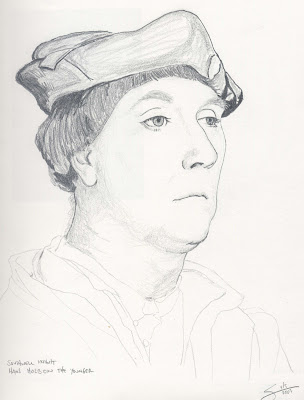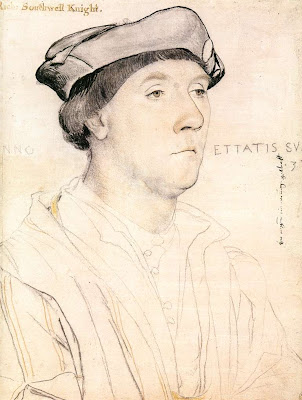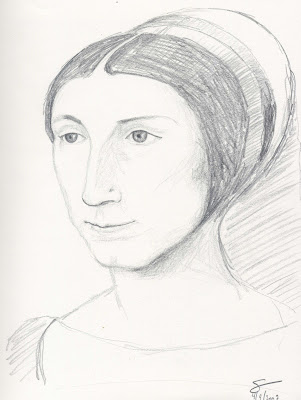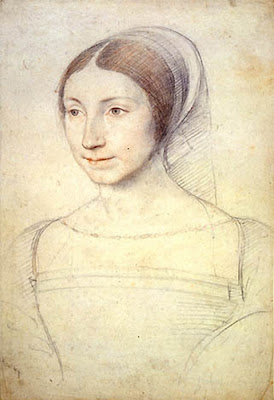

I'm not as happy with the second one, based on Jean Clouet's "Portrait of a Young Woman". The biggest problem is that the drawing I had to base it on is only about 1 1/2" high, and my drawing is 9 or 10 inches high, so there wasn't much detail to follow. I guess I got the proportions mostly correct, so the exercise wasn't a complete failure.


8 comments:
I think copying original master drawings is a great way to learn and here are some tips to check your work when done to see how well you did.
Start by always making your drawing size (not paper or canvas size) the same proportions as the original. Do this by measuring the original drawing's height and width and drawing a box on you paper the same size (even if you are not going to draw the whole figure). This may take some time at first but you will get the hang of it.
Now when you are finished drawing your copy of the original you can take some tracing paper and quickly copy the outlines of your finished drawing and place it over the original to see how close you came.
The object of course is not to make an exact copy. The object of checking by overlaying is to see where you were off and correct the problem the next time. You will be surprised how your eye will deceive you into thinking your proportions are right when they are slightly off.
After you draw for a while you will be able to look and see where you varied but the tracing paper will allow you to see for yourself in the beginning and this will help you to learn with out having an instructor present who can see and critique your work with a trained eye.
Hope this is some help.
Thanks a lot, anonymous, for the great tips. I really appreciate you taking the time to leave feedback. I'll give this a try, and I'm sure you're right - I'll be surprised how far off my drawings are, even though to the naked eye they may look pretty close.
Thanks again for the feedback.
I was looking at your drawings again after I wrote the original post and the individual features are really quite well done.
I find the hardest thing in drawing human heads is getting the general skull shape accurate. As an analogy to your cartoon drawings, there you started with a basic round head shape or volume and put the features "on it". To practice this technique with human heads you might want to search for pictures of human skulls online or get a plastic skull model and draw that. When I did that I was amazed at how complex the human skull is and how little I knew about how it was put together and how it's shape affects the "features" (eyes, mouth, etc.) attached to it. Hope these hints help and keep up the good work.
Thanks again, Anonymous. There seem to be two schools of thought when it comes to drawing - those who say you must study anatomy to really understand how to draw people, and those (like Edwards, who wrote "Drawing on the Right Side of the Brain") who say to just draw what you see. I can see both sides, but I tend to believe that people who want to draw people well should do just what you describe. I really appreciate all of your great feedback. I'm afraid that since I'm not a real artist, the visitors to my site tend to come and leave without bothering to offer helpful suggestions as you have. I hope you'll come back and offer tips in the future.
I know what you mean. As soon as people hear the word anatomy they kind of freak out. I had been drawing for years and was never really confident drawing people because I never really knew zip about basic anatomy. But instead of studying bones and muscles which are really complex start out
with the same cartoon approach to people. In other words use stick type figures only a little more complex. 2 lines for arms (upper and lower arm), 2 lines for legs, a box for hips and a box for the chest, a large circle for the head and 4 small circles for hands and feet. These are like the basic head shapes in your cartoon drawings only for the large parts of the body. You can draw these slightly more complex stick figures in a thousand different
positions for practice. Running, standing, sitting, arms out, up, etc. Don't try to make them look like real humans, just try to get used to the basic proportions. If you aren't sure what the proportions are, look at your self in a mirror. How far down do your arms come below your waist when at your sides. How big should the head be? Draw a really big head, then a really small one and your eye will tell you somewhere in the middle is right. Don't worry about elbows and knees just make little circles where upper and lower limbs meet. Once you know the basic forms then you can take any human in any position and kind of reduce them quickly in your mind to the basic shapes. Same thing with a skull. Don't try to draw any detail just the basic shapes. Very cartoonish like a pirate skull. Then you can see how the jaw holds the teeth and the lower jaw defines the jaw line etc. Hope this gives you some good ideas to work on. Gotta run I got some drawing to do....Clint
Clint, I really appreciate all of your detailed comments. I'll start practicing on that. Do you have any books/web sites that you can recommend?
Stephen,
I can't really recommend any specific books on instruction but here's a list of things to try:
Check out the section on artists at your local lending library. Take home books for as many artists as you can. Modern artists, classical artists, everything. Take them home and just flip through them and see if anything catches your eye. If you have a scanner scan a page or two from many different artists and keep them as a kind of digital scrapbook. Print out color copies of the paintings and drawings you like and hang them on your wall and live with them. In books on painters look for any drawings or sketches that an artist may have done. I find drawings or "studies" by famous artists are great because they show the artist exploring subjects in a casual way. Also I would head to the local art museum and take a sketchbook and pencil and wander till something catches your eye. Also bookstores for art museums are great places to find art books. And I also like to sketch from sculpture since it’s three-dimensional and you can sketch it from all angles. Look for outdoor sculpture gardens. Looking at art in museums will show you how great artists tackled subjects and will teach you VOLUMES! When you learn to read an artwork and see how an artist made the decisions that resulted in the final painting or drawing you can compare that to how you would do it. And don't look casually. Get your nose in close and look. Once you learn to "read" an artwork it’s almost like looking over the artist's shoulder and listening to him explain how and why he did what he did. Start to think of yourself not as some one going to look at “art” but as an artist going to hang out with the other artists. Take a "docent" tour where an expert takes a group through the museum and talks in detail about various paintings or artists. Rent one of those prerecorded tours where you can use headphones and walk around the museum on your own and listen to information at your own pace. Each time you go to the same museum see if certain paintings become "favorites" and try to figure out why. Go see traveling exhibitions when they come to your local museum. Do a Google search and get the website for your local museum (they all have one) so you can keep up with events. Do website searches for famous museums around the world and explore their collections. The Louvre, The Metropolitan, MOMA, The National Gallery of Art, the list is endless. The whole point of exposing yourself to as many artists and styles as possible is you will begin to see that there isn’t just one way to draw or paint a subject. Like having only one cookbook on one type of food to learn to cook. You may learn Italian cooking but miss out on French or Oriental. Hope this gets your creative side going…
Man, oh man, thanks, Clint for taking me under your wing and giving me all these helpful tips. Fortunately, I realize that honing my skills will be a life-long process, and I realize I have so much to learn. I work at a university so I have access to lots of resources, including the library, and I live in a big city with lots of museums. I love all of your feedback, and I hope as I post more pieces on my blog, you'll come back and offer some more of your helpful comments. Thanks again.
Post a Comment